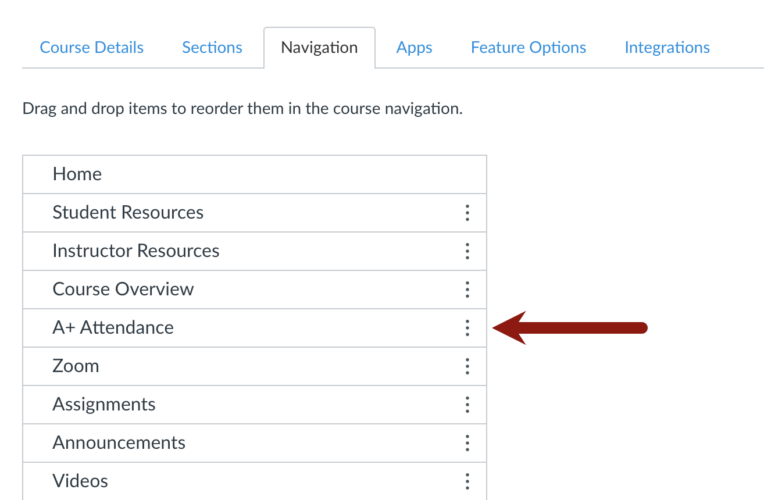At a Glance
aPlus+ Attendance integrates into your Canvas course, offering a way to track and manage student attendance. It provides a centralized system for managing student attendance, offering flexible check-in options and an optional integration with your Canvas gradebook.
In this guide for teaching teams, you’ll learn how to:
- Enable the tool in your Canvas site
- Add class sessions to your course calendar in Canvas
- Set up aPlus+ Attendance for your course and import existing calendar events
- Display a static or rolling code during class or manually record attendance in aPlus+ Attendance
IMPORTANT: When adding class sessions to your Canvas calendar, use a unique and consistent naming convention, such as “[Course #] Class Session”. This practice makes it easier to filter and import only class sessions into aPlus+ later, distinguishes them from other calendar items, and improves overall organization. By adopting this strategy, you’ll streamline your workflow and maintain a well-organized course schedule.
Step 3: Setup Your Course in aPlus+ Attendance
When you first access aPlus+ Attendance in your Canvas course, you will be prompted with the Attendance Setup screen. We recommend selecting the following options:
In your Canvas course, click on A+ Attendance in the Course Navigation Menu.
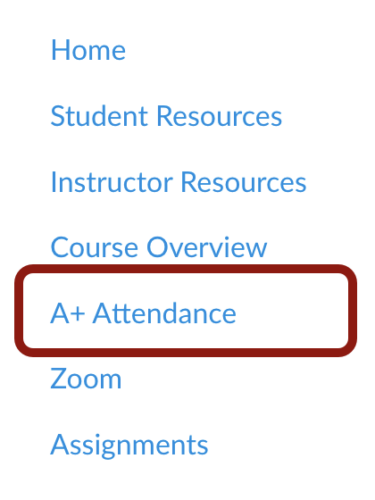
- On the Attendance Setup screen, select the Import Canvas course calendar events checkbox. Note: By default, all calendar events in your Canvas course will be imported into aPlus+ Attendance.

- From the Imported session weighting drop-down menu, select one of the following options:
- Equal sessions (1 point): Every session is treated equally regardless of session duration.
- Note: This option is the most common and recommended.
- Hours duration (fractional): Sessions are weighted relative to their duration with no rounding.
- Hours duration (rounded up): Sessions are weighted relative to their duration but are rounded up to the next hour. For example, a 95-minute session would have a weighting of 2.
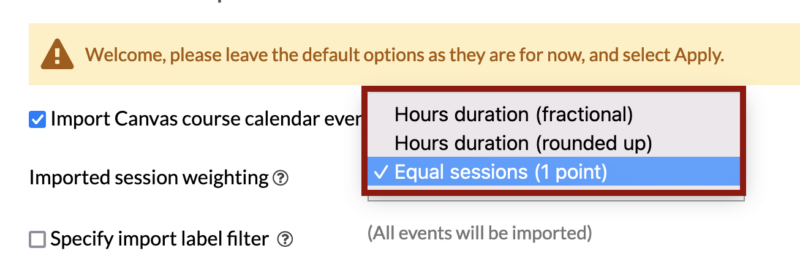
- OPTIONAL – NOT RECOMMENDED: If your course has multiple sections with separate timetables, and you would like to merge them ALL into a single timetable for the course, click the Merge multiple section calendars into one checkbox.
- Note: Selecting this option is NOT recommended. This setting should be used with care as it is not possible to undo without some manual clean-up of attendance.
- OPTIONAL: If you’d like each student’s attendance records synced to an assignment and appear in your Gradebook, select the Record attendance as assignment grades checkbox and do the following:
- Note: With this option selected, a Canvas assignment will be created in your course, appearing on the Assignments page and in your Gradebook. If your course’s Grade Posting Policy is set to Manual, students won’t be able to see their attendance grade synced from the aPlus+ Attendance tool unless you manually post them.
- In the Assignment Name text box, enter a name for the Canvas assignment (e.g., Attendance).

- In the Calculations drop-down menu, select from the following options:
- Record attendance proportionally: Calculate attendance based on the proportion of sessions attended to sessions taught so far. This proportion is then applied to a predefined point value for the attendance assignment.
- Example: If a student attends 8 out of 10 sessions, and the total attendance points available is 100, the student would earn 80 points (8/10 * 100).
- Penalty rules – percentage impact on final grade: Set attendance rules that, when violated, apply a percentage penalty to the student’s total grade for the course.
- Example: If a student misses more than 3 classes, a 5% penalty is applied to their total grade. If the student’s total grade was 90%, it would be reduced to 85%.
- Penalty rules – points impact on weighted attendance: Set attendance rules that, when violated, apply a fixed points penalty to the student’s grade.
- Example: If a student is late more than 5 times, a penalty of 10 points is applied. If the student’s total attendance points were 85, it would be reduced to 75.
- Record attendance as raw points: Enter the total number of sessions and assign a total point value for attendance. Each session attended contributes proportionally to the total attendance points. The attendance score is based on the total planned sessions, not just those that have occurred.
- Example: If there are 20 total sessions and attendance is worth 100 points, each session is worth 5 points (100/20). If a student attends 15 sessions, they would earn 75 points (15 * 5).

- IMPORTANT: Select the Select additional instructor users checkbox and select all teaching assistants (TAs) in the list.
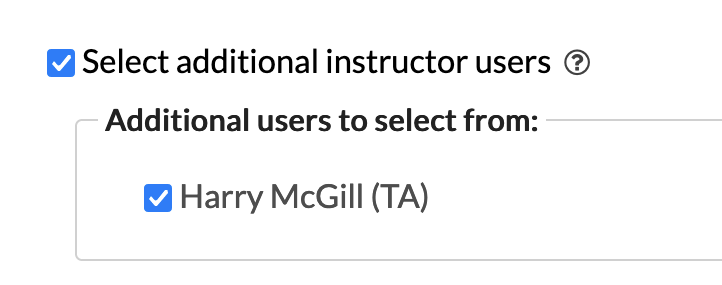
- Click the Apply button.

Note: You can access the Attendance Setup screen at anytime by clicking on Attendance Setup in the top menu of aPlus+ Attendance.

How to Take Attendance
What attendance options are available?
With this tool, you have two convenient options:
IMPORTANT: In aPlus+ Attendance, a student’s unmarked attendance records are not counted. For example, a student has an “Attended – On Time” status for two of three class sessions, but the third session remains unmarked. When this student clicks on A+ Attendance in the Course Navigation Menu, their attendance record will display as 2/2.
To ensure accuracy, make sure you’ve applied an attendance status (e.g., Attended – On Time, Absent – Excused) for each student in every class session.
Manual Entry by the Teaching Team
With this option, you can manually record student attendance directly in your Canvas course.
In your Canvas course, click on A+ Attendance in the Course Navigation Menu.

- IMPORTANT – DO NOT SKIP THIS STEP: In the top menu, click on the Section drop-down menu [1], and select the section that you want to take attendance for [2].

- Note: All MIT Sloan Canvas sites have a section for the members of the teaching team (e.g., faculty, course admins, and TAs). When accessing aPlus+ Attendance in your Canvas site, the Teaching Staff section may be selected by default. It’s important to select a section of students before taking attendance.
- Navigate to the class meeting date you want to take attendance for and click on the column header.

- Your class roster for the selected section will appear.
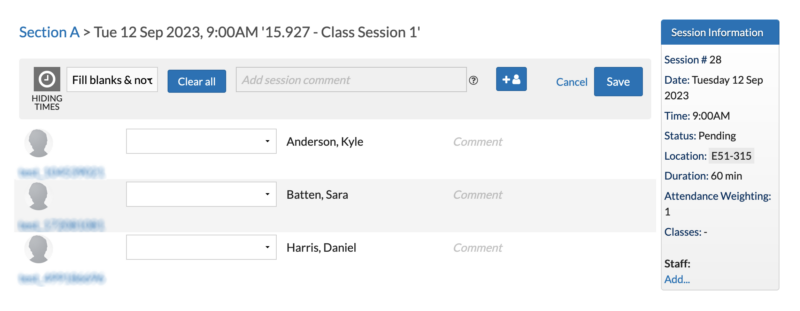
- Click on the Attendance Status drop-down menu for a student.

- In the Attendance Status drop-down menu, select the appropriate attendance status (e.g., Attended – On Time, Absent – Excused) for that student.
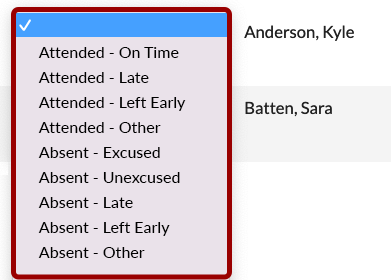
- OPTIONAL: In the Comment text box, add a comment.

- Note: These comments are currently HIDDEN from students. Only members of the teaching team can view them.
- Repeat Steps 5-7 until you’ve recorded the attendance of each student in the selected section.
- Click the Save button in the top-right corner of the screen to save your changes.
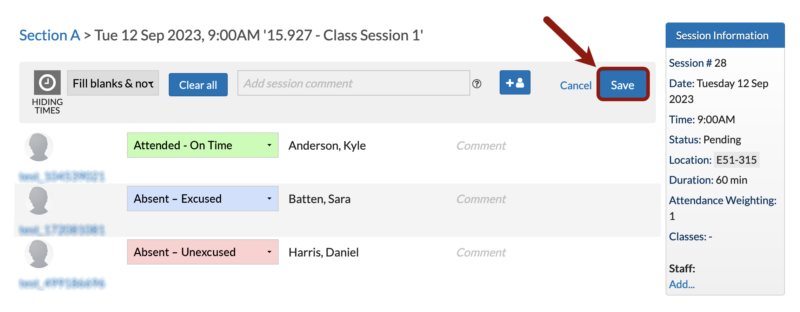
Student Check-in
With this option, you can generate a code, either static or rolling, to display during class. Students can then enter this code on their laptop or mobile device to self-register their attendance.
In your Canvas course, click on A+ Attendance in the Course Navigation Menu.

- IMPORTANT – DO NOT SKIP THIS STEP: In the top menu, click on the Section drop-down menu [1], and select the section that you want to take attendance for [2].

- Note: All MIT Sloan Canvas sites have a section for the members of the teaching team (e.g., faculty, course admins, and TAs). When accessing aPlus+ Attendance in your Canvas site, the Teaching Staff section may be selected by default. It’s important to select a section of students before taking attendance.
- Before your class session, click Codes in the top menu of aPlus+ Attendance.

- In the Attendance Codes window, the next 48 hours worth of class sessions, and the corresponding auto-generated code for each session will appear.
- These are the unique codes you can provide to your students how and when you choose (e.g., on the projector for the first 5 minutes of class, written on the chalkboard at the front of the room).
- Note: By default, attendance codes are available 30 minutes before to 30 minutes after the start time.
- From the Entry method drop-down menu, select from the following options:
- Static Code: With this entry method, the code will stay the same throughout the entry window. If you select this option, do the following:
- Click on the Down Arrow icon for a class session.

- Under Time Window, select from the following options:
- Default entry time window: This will use the default time window (30 minutes before to 30 minutes after the start time).
- Manual entry: This allows you to open and close the time window at your discretion.
- Specify time window: This allows you to define your own time window in advance.
- Disabled
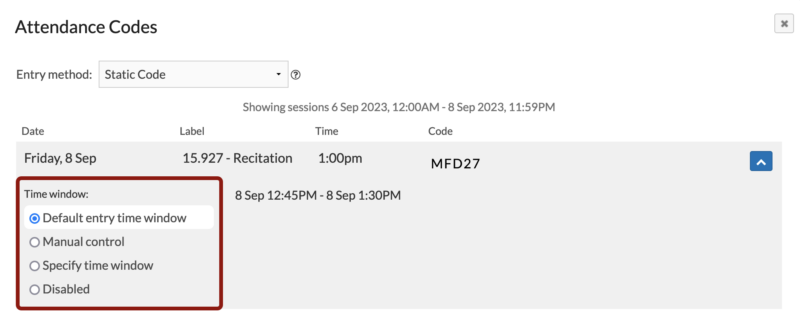
- Take note of the unique code generated for this session, and provide it to your students (e.g., on the projector for the first 5 minutes of class, written on the chalkboard at the front of the room). Note: When students enter the code using their devices, the code is NOT case-sensitive.
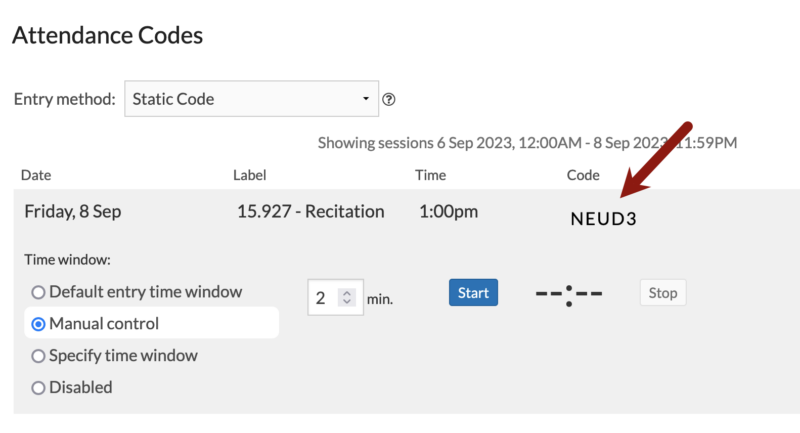
- Rolling Code: With this entry method, the code will change depending on the selected setting (e.g., every 60 seconds). If you select this option, do the following:
- Click the Start Rolling Code button.
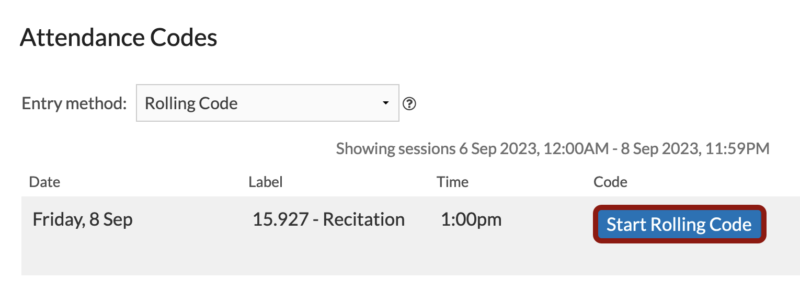
- To change how often the code is changed, click on the Rotation drop-down menu in the top-left corner (e.g., 60 second rotation).

- Take note of the unique code generated for this session, and provide it to your students (e.g., on the projector for the first 5 minutes of class). Note: When students enter the code using their devices, the code is NOT case-sensitive.

Note: When a student successfully checks in using a unique code, you’ll see their attendance status listed as “Attended – Code” in the system.

FAQ
Which roles on our teaching team can access and use aPlus+ Attendance in our Canvas site?
Access to aPlus+ Attendance in your Canvas site is available to specific roles within the teaching team. These roles include:
- Teachers
- Primary Course Admins
- Course Admins
- Teaching Assistants (TAs)
What are the available attendance statuses in aPlus+ Attendance?
The following table provides example use cases and the point value for each attendance status:
|
Status |
Example Use Case |
Point Value |
|
Attended - On Time |
A student arrives at class promptly at 9:00 AM for a class that starts at 9:00 AM. |
1 |
|
Attended - Code |
A student checks in using a unique code provided at the beginning of the class session to verify attendance.
Note: This status is automatically applied when students check-in using a unique code. |
1 |
|
Attended - Late |
A student arrives at 9:15 AM for a class that started at 9:00 AM. |
1 |
|
Attended - Left Early |
A student, who initially attended the class on time, had to leave at 10:00 AM for a medical appointment. |
1 |
|
Attended - Other |
A student attends a live broadcast of the class from another location due to a conference commitment. |
1 |
|
Absent - Excused |
A student provides a doctor's note ahead of time stating they will be out sick and won't be attending class. |
1 |
|
Absent - Unexcused |
A student misses class without giving any prior notice or reason to the teaching team. |
0 |
|
Absent - Late |
A student arrives so late that they missed the majority of the class session, yet it wasn't long enough to be considered fully absent. For example, a student arrives at 10:15 AM for a class that started at 9:00 AM and lasts until 11:00 AM. |
0 |
|
Absent - Left Early |
A student attends the initial 10 minutes of a class and then leaves without notifying anyone and misses the majority of the class session. |
0 |
|
Absent - Other |
A student is on a school-sanctioned activity or trip and provides advanced notice but doesn't fit into the excused or unexcused categories. |
0 |
What happens if I leave a student’s attendance record unmarked (empty) for a class session?
IMPORTANT: In aPlus+ Attendance, a student’s unmarked attendance records are not counted. For example, a student has an “Attended – On Time” status for two of three class sessions, but the third session remains unmarked. When this student clicks on A+ Attendance in the Course Navigation Menu, their attendance record will display as 2/2.
To ensure accuracy, make sure you’ve applied an attendance status (e.g., Attended – On Time, Absent – Excused) for each student in every class session.
How do my students check in using a unique code on their devices?
If you want to use the Student Check-in option during class, students can access aPlus+ Attendance and check in via a web browser (e.g., on their laptop) or the Canvas Student app on their iOS or Android devices.
For step-by-step instructions, refer to How to Check into aPlus+ Attendance with a Unique Code as a Student.
What can my students see when clicking on A+ Attendance in the Course Navigation Menu?
Students can see code entry options (when enabled by the teaching team) and how many times their attendance has been recorded thus far.

How do I bulk apply attendance labels in aPlus+?
Bulk applying attendance labels is a time-saving feature in aPlus+ that allows you to quickly fill in multiple attendance records after a class session. This is particularly useful for recording attendance for students who didn’t check in during class or for updating multiple records simultaneously.
- In your Canvas course, click on A+ Attendance in the Course Navigation Menu.
- In the top menu, click on the Section drop-down menu [1], and select the section that you want to take attendance for [2].

- Navigate to the class meeting date you want to take attendance for and click on the column header.

- Your class roster for the selected section will appear.

- Click the Fill Blanks & No Data drop-down menu.
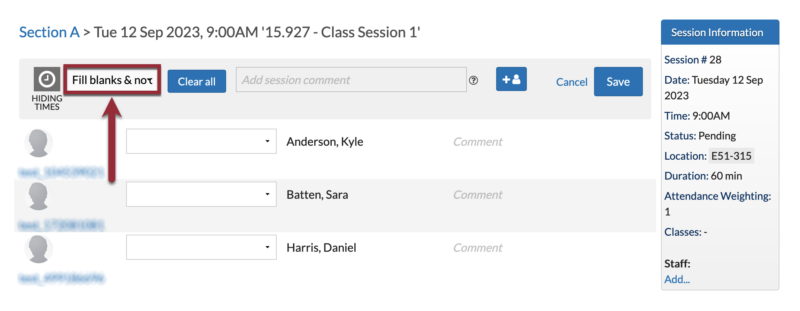
- Select the appropriate attendance status (e.g., Attended-Late, Absent-Excused).
- Click the Save button in the top-right corner of the screen to save your changes.

Important Notes:
- This process only affects empty attendance records, preserving any previously recorded data.
- You can use this feature multiple times with different statuses if needed.
- Always double-check your selection before saving to avoid errors.
How do I generate an attendance report in aPlus+?
- In your Canvas course, click on A+ Attendance in the Course Navigation Menu.
- Click on Reports in the top menu.

- Choose the type of report you need (e.g., Attendance Summary, Attendance by Date, Attendance by Sequence, Comments, Date of Last Attended).
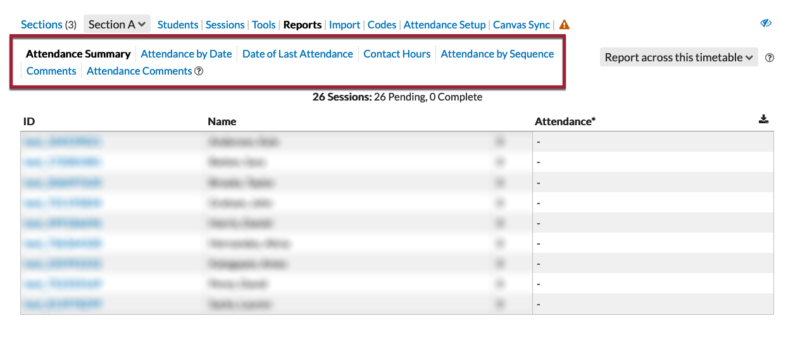
- Select your desired data range and columns.
- To export, click the Export icon in the top right of the data table.

- Choose CSV or Excel format for your export.
To learn more, refer to Course Attendance Reports.
How to Get Support
Get in touch with our team by submitting a ticket. We’ll get you to the resources and support you need right away.
